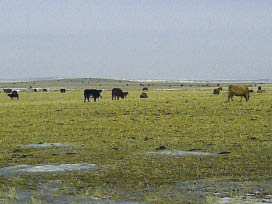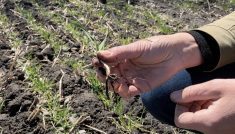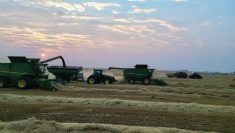Scott Lehr’s winter cereal seeding plays a double-header. It serves as winter pasture for his bred cow herd, and the next summer he usually harvests a productive silage crop off the same stand as feed for backgrounding calves.
It’s a system that may not work in all areas of Western Canada, but for the southeast Alberta rancher the combination of relatively low snow cover, usually milder winter temperatures and having irrigation available makes for a simple, lower-cost winter feeding system.
Lehr, who along with family members operate Short Grass Ranch just north of Medicine Hat, has been using winter cereals for winter pasture since 2005. He works mainly with winter wheat and winter triticale although occasionally adds spring cereal crops or vetches to the mix.
Read Also

Claas brings 1000 Series SP forage harvesters to Canada
In mid-August, Claas unveiled its new line of Jaguar forage harvesters at an event in Visalia, California, deep in the heart of that state’s dairy region.
“We are pushing the limits with winter grazing and some years we may have a bit of winterkill, but usually the winter cereal bounces back the next spring,” says Lehr. “Even if we do have some winterkill and have to reseed, I know we are definitely dollars ahead compared to putting up hay or hauling out feed.”
Spring crops first
Lehr seeds spring cereals such as barley, triticale and wheat on part of 950 acres of irrigated land in the spring and harvests silage in August. He also usually has about 200 acres of corn, also harvested for silage.
Once the spring-seeded cereals have been silaged, he then reseeds about 600 acres of the fields to winter cereals. Most of the time he seeds AC Bellatrix, a Hard Red Winter wheat, although he has also tried CDC Ptarmigan, a soft white winter wheat. Of the triticale varieties he prefers Pika winter triticale.
For the past couple of years he has also added about two pounds of tillage radish seed to the winter cereal seedings. It provides some variety in the cow diet and the deep roots of the radish also help loosen the soil on the fields, which are direct seeded. He applies about 55 pounds of nitrogen per acre at time of seeding.
“I tend to prefer the Bellatrix and Pika because they are very leafy varieties and very productive,” says Lehr.
The 1,100-head cow herd is moved onto the winter cereal seeding in late October/early November as cattle come home from grazing on the mostly native grass summer pasture. Calves are weaned and moved into backgrounding feedyards, while the cow herd grazes the winter cereals.
“We usually put them on the winter cereals in November and they stay there until they start calving in April,” says Lehr. “Most years snow isn’t a problem in this area and they graze all winter. Even a few inches of snow isn’t a problem, but if you get a foot or more, or if it begins to get crusty then they have a hard time grazing.”
Along with the winter cereal grazing, Lehr does provide a chopped hay and straw supplement. The hay and straw is top dressed with a liquid molasses mineral.
From the Canadian Cattlemen website: Mature cereal forage is better than you think
“Their first choice is to graze the winter cereal and most days they barley look at the hay or straw,” he says. “We add the mineral supplement because they like the taste and at least we know they are getting their minerals.”
As the cow herd moves off the winter cereal pastures in April, Lehr applies between 120 and 140 pounds of actual nitrogen (based on soil test recommendations) with a 3/4-inch knife on 12-inch spacings. And as needed he turns on the irrigation system.
“We really push the grazing,” he says. “The cows have full access to the seeding over the winter and they take it right down. Sometimes it looks like summerfallow when they are moved out. Even though we hit it hard it usually bounces back quite well.” Some years there are winterkill areas that will be reseeded to a spring crop, but he says usually with fertilizer and water the winter cereals come back nicely.
The summer after grazing, the winter cereals produce a 12- to 13-tonne silage crop. He says there is a possibility the winter cereal stand would be good enough to let mature to produce a grain crop, but he wants the silage “and with the fertility we have on there it would be badly lodged,” says Lehr.
Radish roots work
He appreciates having tillage radish in the mix to help break through any compacted soil below the surface. The radish tuber grows about six to eight inches long, while the taproot extends at least 16 inches into the soil profile.
“We do a lot of digging when the crop is growing to see where the roots are,” he says. “With canola, it will go down so far and then the roots turn sideways as soon as it hits a hard layer. With sunflower we find the roots just go fibrous when they hit any hard soil, but with the radish those roots just go right down. And the crop has good feed value too. The cows clean them up.”
Even though the winter cereal produces a very lush pasture, particularly when the cows are first turned in, the herd experiences no adverse effects and quite easily make the transition from native grass to the cereal seeding.
The practice of grazing winter cereals has caught the eye of Farming Smarter, the southern Alberta applied research association. Working with Lehr, Farming Smarter has launched a research project to evaluate the potential of the dual-purpose crop. With the first year of the three-year project launched in 2013, the study is looking at different winter wheat, winter triticale and fall rye varieties, at different seeding rates, and also in crop blends to see if there are any outstanding performances. The project will also look at the economics of using winter cereals.
“The economics is something I would like to nail down a bit better,” says Lehr. “I really haven’t looked at that myself. I know what we’re doing is more economical than producing and feeding hay or silage, but it would be good to know how our daily winter feeding costs stack up compared to other feeding options.”

















